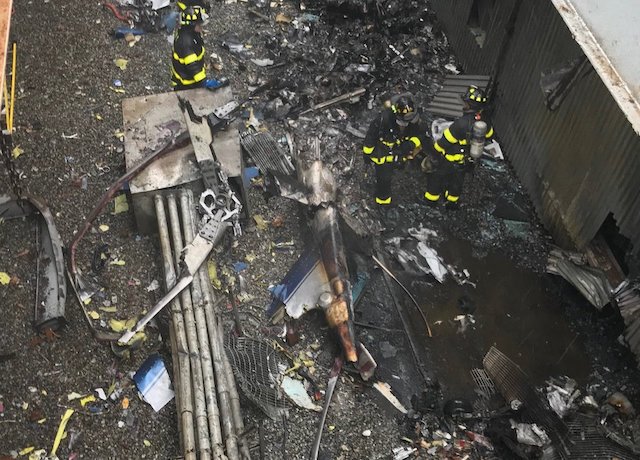Pilot Who Crashed Helicopter In Midtown Not Licensed To Fly In Bad Weather
June 12, 2019, 11:10 a.m.
"Should the helicopter have been flying? I don't know yet."

From the roof of 787 7th Avenue
Tim McCormack, the helicopter pilot who died in a crash landing on the roof of a Midtown skyscraper on Monday, lacked the requisite license to fly in heavy cloud cover, and may have been lost when he went down atop the AXA Equitable Center.
At a press conference convened outside 787 Seventh Avenue on Tuesday, an investigator for the National Transportation Safety Board, Dan Brazy, explained the team's most likely hypothesis about the crash. According to the NY Times, Brazy said that McCormack picked up Daniele Bodini, formerly the U.N. Ambassador for San Marino and currently the founder and chairman emeritus of American Continental Properties, in Westchester on Monday morning. He had made the trip many times before, having flown for the real estate company for five years. McCormack dropped off Bodini at the 34th Street helipad (near the East River) about 15 minutes later, without any problems.
He reportedly spent the next two hours at the heliport, apparently waiting for Monday's gray skies to break. Around 1:32 p.m., McCormack seemed to decide he had a clear path through the clouds and took off for the Linden Airport in New Jersey, where he typically parked the helicopter. Five minutes later, he radioed to alert the 34th Street heliport he might need to turn around. Brazy said that McCormack "did not know where he was" when he made the call, according to the Times.
"Should the helicopter have been flying? I don't know yet," Brazy added. Videos published on Instagram in the minutes preceding the crash show a helicopter flying erratically over the East River:
McCormack had many years of flight experience under his belt, but according to NBC News, the Federal Aviation Administration has determined that he was not "instrument rated," a prerequisite for pilots heading out in wet, cloudy weather like Monday's: They need to give air traffic control their flight plan, and they need to know how to navigate in low-visibility conditions using just instruments, not sight.
McCormack, meanwhile, was certified to fly with a minimum of three miles of visibility, whereas Monday permitted only about one-and-a-quarter miles. Flying without a full dashboard of tools to orient you in fog leads to "spatial disorientation," Al Yurman, a former air safety investigator with the NTSB, told NBC. "It's like putting a blindfold on: Turn yourself around three times and see if you know where you are."
By 1:43 p.m., McCormack had careened into the 51st floor roof of 787 Seventh Avenue, taking out mechanical equipment on the roof and sending the helicopter—an Agusta A109E—up in a blaze. McCormack did not survive the collision, and was the only person inside the chopper at the time.
The impact shook the building forcefully enough that some people inside thought they were experiencing an earthquake. The incident also brought up traumatic memories: "If you're a New Yorker, you have a level of P.T.S.D., right, from 9/11," Governor Andrew Cuomo said in remarks after the crash. That PTSD might easily be triggered by an aircraft speeding into a building.
Susan Stolzer, who works in the high-rise and was on the phone with a client when the chopper hit the roof, told Gothamist that her office was closed on Tuesday. "Engineers, consultants, and restoration crews [are] working on it to ensure that it's safe and operational," Stolzer said Wednesday morning. At time of publication, the building still hadn't reopened.